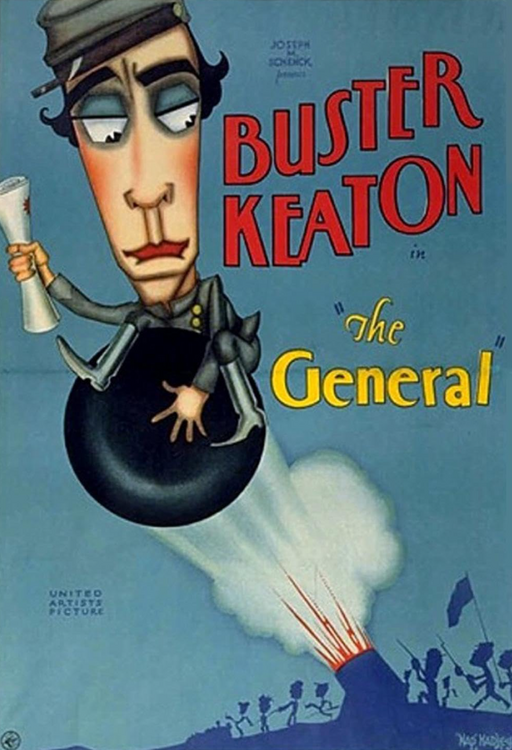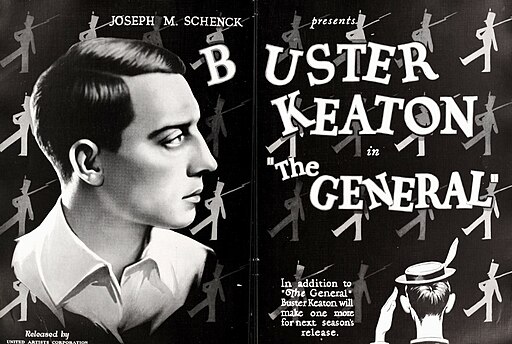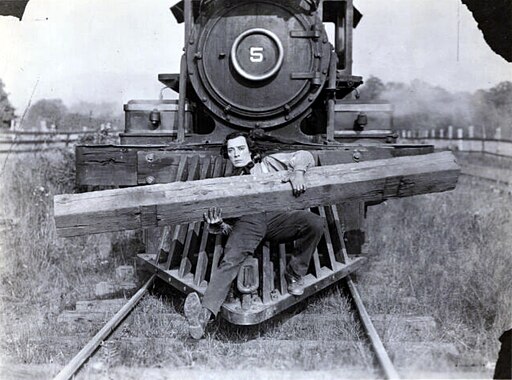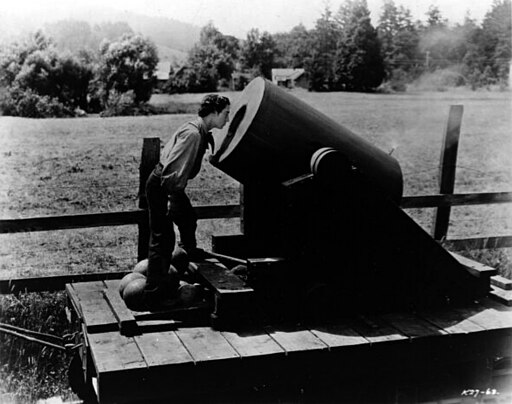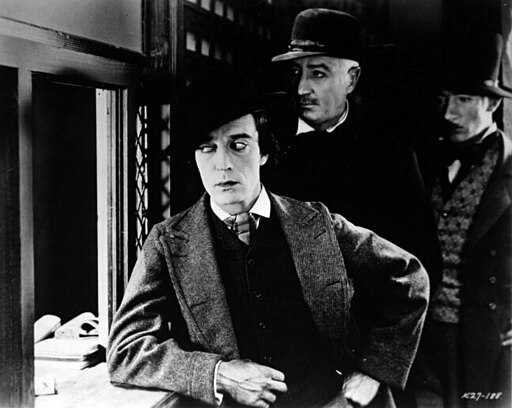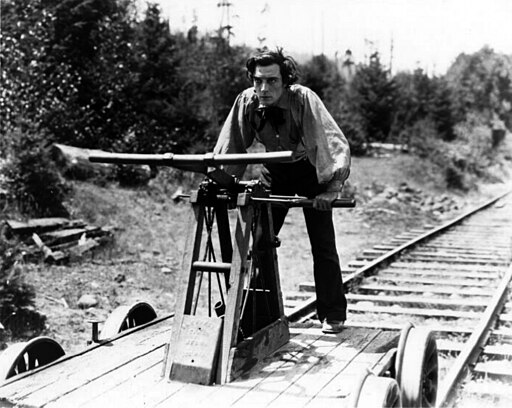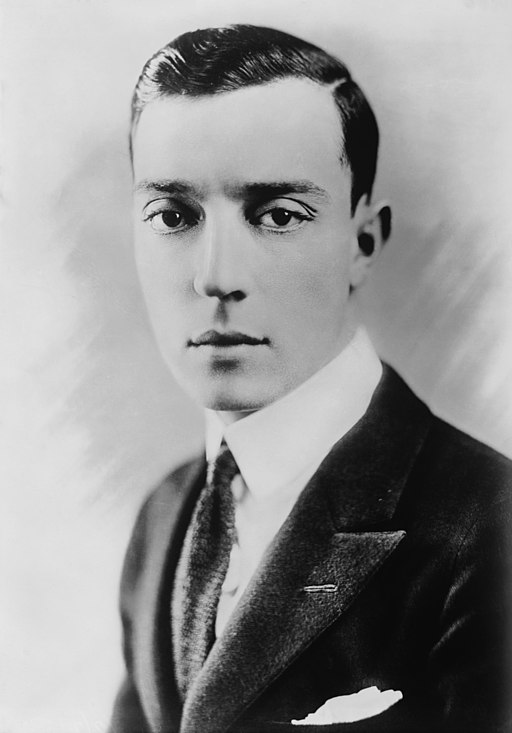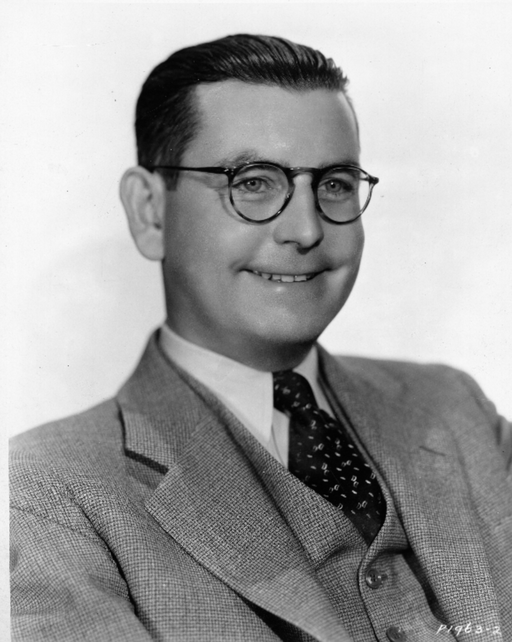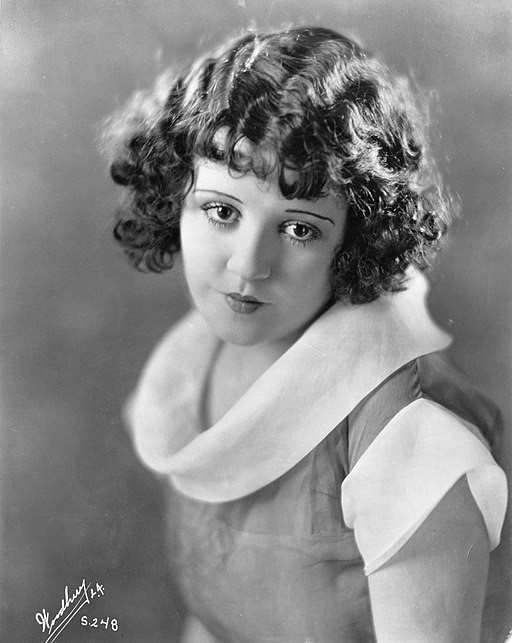The General - 1926
back| Released by | United Artists |
| Director | Buster Keaton and Clyde Bruckman |
| Producer | Joseph M. Schenck |
| Script | Written by Buster Keaton and Clyde Bruckman, the screenplay was based on the memoir The Great Locomotive Chase by William Pittenger, reflecting an actual event during the American Civil War |
| Cinematography | Bert Haines and Devereaux Jennings |
| Music by | Silent film |
| Running time | Approximately 75 minutes |
| Film budget | $ 750.000,- |
| Box office sales | $ 1 million |
| Main cast | Buster Keaton - Marion Mack - Glen Cavender - Jim Farley |
The General
A Gem of a Comedy
The General is now considered one of the greatest films ever made, renowned for its physical comedy, clever storytelling, and the incredible stunts performed by Keaton himself. Despite its initial financial failure, it has been re-evaluated by critics and audiences alike, securing its place as a classic in silent cinema.
Related
The General – 1926
Summary:
"The General" is a silent comedy set during the American Civil War, showcasing the adventures of Johnnie Gray, played by Buster Keaton, who is both the engineer of a locomotive named The General and the film's protagonist. Despite its comedic tone, the film accurately portrays elements of the historical period, making it a unique blend of humor and history.
The story begins in Georgia, where Johnnie attempts to enlist in the Confederate Army but is rejected because his work as a train engineer is considered more critical to the war effort, though he is not informed of this reason. As a result, he feels dishonored when his beloved, Annabelle Lee (played by Marion Mack), believes he did not enlist due to cowardice, leading to a rift between them.
The plot thickens when Union spies steal The General, with Annabelle inadvertently aboard. Johnnie embarks on a daring solo mission to rescue both his love and his locomotive. His journey is fraught with challenges, including navigating enemy territory, enduring physical hardships, and employing ingeniously comedic strategies to overcome obstacles. The film reaches its climax in a thrilling chase sequence as Johnnie recovers The General and saves Annabelle, proving his bravery.
Keaton's performance is remarkable for his physical comedy and daring stunts, executed with precision and without the use of stunt doubles. The film's action sequences, particularly the train chases and battles, are meticulously choreographed and remain impressive by today's standards.
Analysis:
"The General" stands out for its seamless integration of comedy and action within a historical context. Keaton's use of authentic Civil War-era locomotives and attention to historical detail adds a layer of depth uncommon in silent comedies. The film is a technical marvel, with its elaborate set pieces and stunts illustrating Keaton's ingenuity and willingness to push the boundaries of filmmaking at the time.
Thematically, "The General" explores concepts of heroism, love, and perseverance. Johnnie's journey is a testament to his unwavering determination and resourcefulness, embodying the silent era's archetype of the "everyman" hero who triumphs against the odds. The film also delves into the irony of Johnnie's rejection by the army due to his critical civilian role, highlighting the unrecognized contributions of many individuals in times of conflict.
Critically, "The General" received mixed reviews upon its initial release and was not a commercial success, partly due to its high production costs and the public's evolving tastes in cinema. However, its reputation has significantly improved over time. Today, it is celebrated for its artistic and comedic genius, innovative techniques, and the physicality of Keaton's performance. It is often cited as one of the greatest films in cinematic history, demonstrating Keaton's mastery of the medium and his legacy as a pioneer of visual comedy.
"The General" is a testament to Buster Keaton's visionary approach to filmmaking, blending comedy, action, and romance in a historically grounded narrative. Its enduring appeal lies in its timeless humor, breathtaking stunts, and the universal appeal of its underdog story, cementing its status as a landmark achievement in the silent film era.
Trailer of The General from 1926:
Full Cast of the Movie:
- Buster Keaton as Johnnie Gray, the train engineer and protagonist.
- Marion Mack as Annabelle Lee, Johnnie's love interest.
- Glen Cavender as Captain Anderson, a Union Army officer.
- Jim Farley as General Thatcher, a Confederate general.
- Frederick Vroom as a Southern General.
- Charles Smith as Annabelle's brother.
- Frank Barnes as Annabelle's father.
- Joe Keaton (Buster Keaton's father) as a Union General.
- Mike Donlin and Tom Nawn as Union spies.
Analysis of the Direction of Buster Keaton and Clyde Bruckman:
The direction of "The General," a masterpiece of silent cinema, showcases Buster Keaton and Clyde Bruckman's innovative and meticulous approach to filmmaking. Their collaboration on this project is a testament to their complementary skills and shared vision, resulting in a film that seamlessly blends comedy, action, and romance within a historical narrative.
Analysis of Direction:
Visual Storytelling and Physical Comedy: Keaton's direction is renowned for its emphasis on visual storytelling and physical comedy, which are central to "The General." Keaton, known as "The Great Stone Face," brought his unique brand of stoic humor and elaborate physical stunts to the film, many of which he performed himself without the use of stunt doubles. This commitment to authenticity and physicality adds a timeless quality to the humor and action sequences, making them as compelling today as they were nearly a century ago.
Historical Authenticity and Detail: Both Keaton and Bruckman were dedicated to historical accuracy in the depiction of the Civil War setting, going so far as to use real locomotives and meticulously recreate scenes based on actual events. This attention to detail extended to the props, costumes, and locations, immersing the audience in the era and adding a layer of depth to the comedic narrative.
Innovative Use of Cinematography: The film's cinematography, overseen by Bert Haines and Devereaux Jennings under Keaton and Bruckman's direction, features dynamic camera work and innovative techniques that were groundbreaking for the time. The use of moving trains as both setting and plot device required precise timing and coordination, showcasing Keaton's ingenuity and his ability to conceive and execute complex action sequences.
Division of Tasks:
While specific details about the division of tasks between Keaton and Bruckman might not be extensively documented, it's known that their collaboration was a blend of Keaton's visual and comedic genius with Bruckman's writing and narrative structuring skills. Here's a general overview of how their tasks might have been divided:
Buster Keaton:
- Keaton was deeply involved in the conceptual and physical aspects of the film, including the design of stunts and the overall visual style. His background in vaudeville and silent film comedy informed the film's physical humor and daring stunts.
- As a co-director and the lead actor, Keaton's vision for the film was instrumental in shaping its direction, from the action sequences to the comedic timing.
- Keaton's hands-on approach likely extended to working closely with the cinematographers and overseeing the film's editing, ensuring that the visual comedy and action were perfectly executed.
Clyde Bruckman:
- Bruckman, with a strong background in comedy writing, likely contributed significantly to the screenplay and the structuring of the film's narrative. His expertise would have been crucial in integrating the comedic elements with the historical backdrop.
- Bruckman may have also played a role in directing the performances of the supporting cast, ensuring that the film's tone and pacing were consistent throughout.
- Given his experience in the film industry, Bruckman would have also contributed to the logistical aspects of the production, collaborating with Keaton on the planning and execution of the film's more complex sequences.
The partnership between Buster Keaton and Clyde Bruckman in "The General" is a prime example of how two creative minds can come together to create a work that transcends the sum of its parts. Their collaboration brought out the best in both directors, combining Keaton's unparalleled physical comedy and innovative filmmaking techniques with Bruckman's narrative skills to create a silent film that remains a landmark in cinema history.
The Masterful Performance of Buster Keaton:
Buster Keaton's performance in "The General" is a masterful display of his unique brand of physical comedy, emotional expressiveness, and unparalleled stunt work, all delivered with his iconic stoic demeanor. His portrayal of Johnnie Gray, the intrepid train engineer, showcases Keaton's extraordinary talents as both a comedian and an actor, and stands as a quintessential example of his craft in silent film.
Physical Comedy and Stunt Work: Keaton's physicality is central to his performance, blending athleticism, precision, and comedic timing to create unforgettable moments of visual humor. His ability to convey complex situations and emotions through action rather than words is unmatched. Keaton performed his own stunts, many of which were highly dangerous and required meticulous planning and execution. For instance, scenes involving high-speed chases on moving trains and narrow escapes from perilous situations are executed with such finesse that they remain breathtakingly impressive even by today's standards. The physical demands of these stunts, coupled with Keaton's unwavering commitment to authenticity, amplify the comedic impact of his performance.
Emotional Expressiveness: Despite his moniker "The Great Stone Face," Keaton's emotional range is subtly but effectively communicated through minute expressions, body language, and the careful timing of his reactions. In "The General," his portrayal of Johnnie Gray's determination, ingenuity, and vulnerability is conveyed with minimal exaggeration, allowing the audience to empathize with his character's journey. Keaton's ability to elicit laughter, suspense, and sympathy, often within a single sequence, demonstrates his mastery of silent film acting.
Comic Timing and Creativity: Keaton's comic timing is impeccable, with each gag and stunt carefully orchestrated to build upon the last, creating a crescendo of laughter and awe. His innovative use of the film's setting and props, particularly the locomotive, showcases his creative genius. The way he interacts with his environment, turning potential disasters into opportunities for humor, highlights his character's resourcefulness and resilience.
Stoicism and Character Depth: A defining trait of Keaton's performance is his stoicism amidst chaos. This not only serves as a comedic contrast to the pandemonium around him but also adds depth to his character. Johnnie Gray's calm determination in the face of adversity reflects a profound sense of duty and loyalty, qualities that resonate with the audience and elevate the narrative beyond mere comedy.
Impact and Legacy: Keaton's performance in "The General" has left an indelible mark on the history of cinema, influencing generations of actors and filmmakers. His blend of physical comedy, emotional depth, and risk-taking in stunt work set new standards for the industry and established him as one of the great pioneers of film. "The General," largely due to Keaton's performance, is not only considered a masterpiece of silent cinema but also a timeless work of art that continues to inspire and entertain audiences worldwide.
Awards and Recognition:
"The General" (1926) is widely regarded as one of Buster Keaton's greatest films and a classic of silent cinema. However, it's important to note that the film was released before the establishment of the major film awards that we are familiar with today, such as the Academy Awards, which were first presented in 1929. As a result, "The General" did not receive contemporary awards or nominations upon its original release.
Over the years, however, "The General" has been recognized for its significant contribution to film history and has received numerous posthumous honors and recognitions, including:
- National Film Registry: In 1989, "The General" was one of the first 25 films to be selected for preservation in the United States National Film Registry by the Library of Congress for being "culturally, historically, or aesthetically significant."
- Critics' and Filmmakers' Polls: The film has frequently appeared on critics' and filmmakers' lists of the greatest films ever made. For instance, it was ranked No. 18 on the American Film Institute's list of the 100 greatest American films in their 1998 survey, AFI's 100 Years...100 Movies.
- International Recognition: "The General" has also been celebrated in international critics' polls, such as the Sight & Sound polls conducted every decade, where it has consistently ranked among the greatest films of all time.

